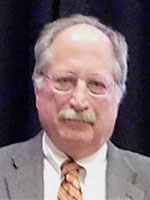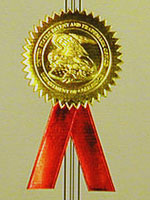Recent News
CHTM Joins NSF's NQVL Pilot Projects
August 9, 2024
OSE PHD, Dr. Xuefeng Li - Wins The Outstanding Interdisciplinary Graduate Programs Award
May 10, 2024
Dr. Ali Rastegari - 2024 OSE Best Dissertation Award Winner
May 10, 2024
2024 OSE Spring and Summer Graduates
May 10, 2024
News Archives
Patent issued for surface plasma wave coupled detectors
October 28, 2016

Steven R. J. Brueck
The United States Patent Office issued Patent No. US 9,466,739 B1 on October 11, 2016 for "Surface Plasma Wave Coupled Detectors" to University of New Mexico inventors and CHTM faculty members Steven R. J. Brueck, Sanjay Krishna, and Seung-Chang Lee. Brueck is a UNM Distinguished Professor, Emeritus, Electrical and Computer Engineering; Physics and Astronomy; and Director Emeritus of CHTM. Krishna is a UNM Professor and Regents Lecturer, Electrical and Computer Engineering, Endowed Chair in Microelectronics; and the outgoing director of CHTM. Lee is a UNM Research Associate Professor, Electrical and Computer Engineering.

Sanjay Krishna
Abstract
The present disclosure relates to an electromagnetic energy detector. The detector can include a substrate having a first refractive index; a metal layer; an absorber layer having a second refractive index and disposed between the substrate and the metal layer; a coupling structure to convert incident radiation to a surface plasma wave; additional conducting layers to provide for electrical contact to the electromagnetic energy detector, each conducting layer characterized by a conductivity and a refractive index; and a surface plasma wave ("SPW") mode-confining layer having a third refractive index that is higher than the second refractive index disposed between the substrate and the metal layer.
Technical field
This disclosure generally relates to plasmonic detectors. In particular, this disclosure relates to plasmonic structures and their use in resonantly enhancing the performance of infrared detectors.

Background
There is increasing interest in using surface plasma waves or other bound local modes to both increase the interaction of incident radiation with detectors and also to provide spectral selectivity. Ongoing work covers both the infrared and the visible spectral regions.
In the visible there is a need for spectral/angular resolution compatible with inexpensive silicon fabrication. While color cameras are ubiquitous, the spectral resolution is provided typically by absorbing dyes, which are increasingly difficult to fabricate with sufficient absorbance as the pixel size decreases, and provide only limited spectral selectivity.
In the infrared, detector signal-to-noise is an important driver. Detectors cooled to cryogenic temperatures provide the highest sensitivity, but require extensive and expensive infrastructure limiting their applicability. Uncooled detectors, typically based on thermal heating of an isolated structure by infrared radiation, have limitations associated with high noise levels and limited response speed.
Surface plasma wave (SPW) and other guided mode interactions provide a method to address some of these issues. There are two related classes of SPWs. For a planar interface between a metal and a dielectric (such as a semiconductor material), there is a mode bound to the interface (e.g., a slow wave that is propagating along the interface and evanescent (exponentially decreasing in amplitude) into both the metal and the dielectric). This wave is well defined for Re(-.di-elect cons..sub.m)>Re(.di-elect cons..sub.d) where .di-elect cons..sub.m is the permittivity of the metal (with a negative real part) and .di-elect cons..sub.d is the dielectric permittivity. For isolated metal structures, there are localized SPW resonances that concentrate the fields, this localized resonance is involved in the well-known surface enhanced Raman scattering (SERS) effect.
Much of the analysis of SPW modes at a planar metal/dielectric interface has considered only a simple two component structure with a top metal, most often the metal layer incorporates a 1D or 2D grating structure to provide the necessary coupling to the slow SPW and a semi-infinite dielectric layer (e.g., to allow for momentum conservation). However, a realistic detector structure has multiple dielectric layers with varying permittivities. These layers could include contact layers with p- and n-type doping, absorber layers (e.g., quantum dots or strained layer superlattices in the infrared), and electrical isolation layers (often of much lower permittivity than the semiconductor). These layers can have a profound effect on the coupling to, and even to the existence of, the SPW and need to be considered in a full device analysis and design. Additionally, this simple two material model typically does not allow for separate indentification of the useful absorption in the absorber layer and of the parasitic absorption in the metal layer and are hence not sufficient for detailed designs.
Source:
U.S. Patent No: 9,466,739


